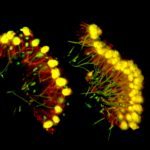Link to Pubmed [PMID] – 30135501
Link to DOI – 10.1038/s41559-018-0641-0
Nat Ecol Evol 2018 09; 2(9): 1358-1376
It is widely held that the bilaterian tubular gut with mouth and anus evolved from a simple gut with one major gastric opening. However, there is no consensus on how this happened. Did the single gastric opening evolve into a mouth, with the anus forming elsewhere in the body (protostomy), or did it evolve into an anus, with the mouth forming elsewhere (deuterostomy), or did it evolve into both mouth and anus (amphistomy)? These questions are addressed by the comparison of developmental fates of the blastopore, the opening of the embryonic gut, in diverse animals that live today. Here we review comparative data on the identity and fate of blastoporal tissue, investigate how the formation of the through-gut relates to the major body axes, and discuss to what extent evolutionary scenarios are consistent with these data. Available evidence indicates that stem bilaterians had a slit-like gastric opening that was partially closed in subsequent evolution, leaving open the anus and most likely also the mouth, which would favour amphistomy. We discuss remaining difficulties, and outline directions for future research.

